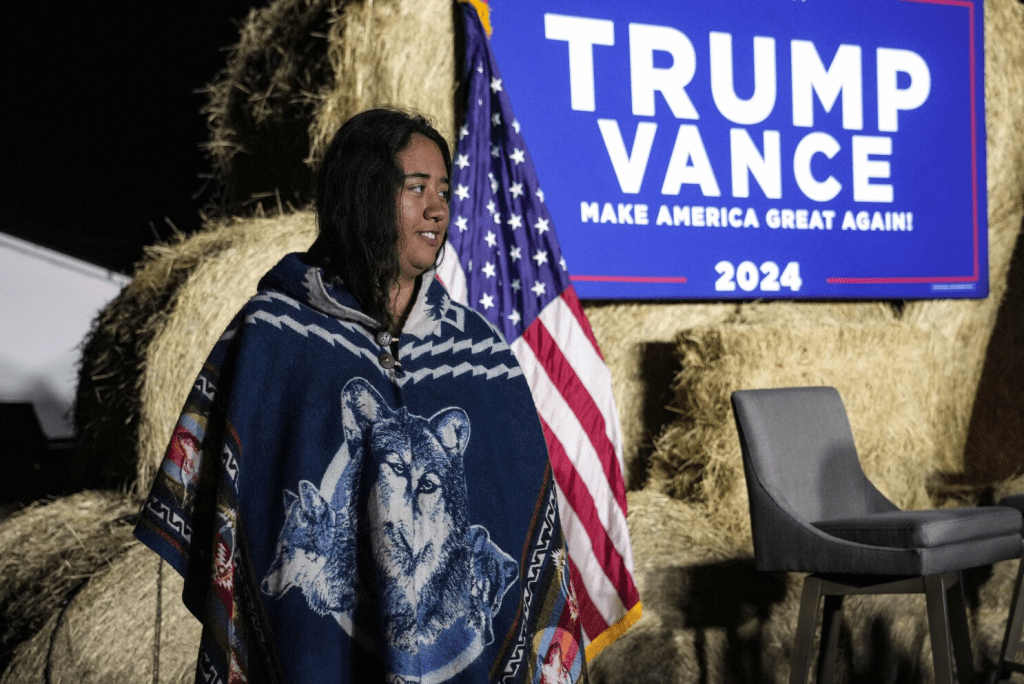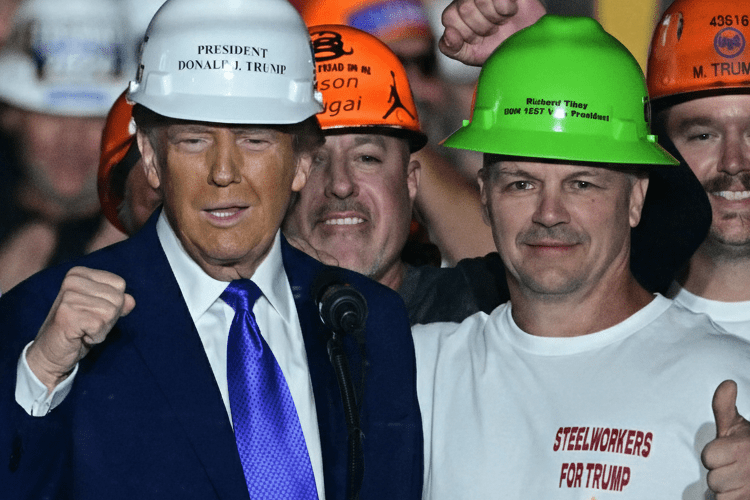While 1 Million Migrants Fade from Workforce
In the rust-dusted heart of Youngstown, Ohio, where the Mahoning River winds like a vein through a landscape scarred by decades of mill closures and unkept promises, 45-year-old Maria Gonzalez wiped the sweat from her brow and slid into the driver’s seat of her newly leased Ford F-150, the keys a symbol of stability she’d chased since her husband’s layoff in the Biden years. It was November 15, 2025, and Maria, a second-generation steelworker’s daughter who’d spent the pandemic cobbling together gig shifts as a home health aide, had just clocked her first full week at the newly revived Vallourec Steel plant—hired through a Trump administration apprenticeship program that funneled $500 million into rust-belt retraining. “I look at my boys now, 12 and 14, and think, this is for them,” she shared in a voice thick with the quiet triumph of a mother who’d traded ramen nights for family dinners, her story one thread in a tapestry of resurgence that’s captured the nation’s imagination. Since President Donald J. Trump’s January 20 inauguration, U.S. Bureau of Labor Statistics data reveals a staggering 2.57 million net job gains for native-born Americans—a figure that’s ignited rallies from Pittsburgh to Peoria, where hard hats and American flags wave like beacons of hope. Yet woven into this narrative of revival is a puzzling counterpoint: over 1 million foreign-born workers have slipped from the labor force, a drop that’s sparked cheers from some quarters as “nature healing” and furrowed brows among economists who see shadows of something more nuanced at play.

Maria’s journey mirrors the broader arc of an economy awakening under Trump’s “America First” blueprint, a vision that promised to prioritize the forgotten men and women who’d borne the brunt of globalization’s grind. The BLS’s October 2025 employment report, released on November 1 and dissected in Table A-7—the gold standard for demographic breakdowns—paints a portrait of targeted triumph. Native-born employment climbed by 2.57 million since January, a 1.8% surge that outpaced the national average and echoed the halcyon days of the late 1990s boom, when factories hummed and families flourished without the specter of offshoring. Steelworkers like those at Vallourec, where a $200 million federal grant under the CHIPS Act extension revived idled lines, credit Trump’s tariffs and tax incentives for the lifeline. “We were ghosts in our own town—now we’re building again,” says foreman Tom Reilly, 52, his callused hands gesturing to a shop floor alive with welders and machinists, many native-born Ohioans who’d despaired after the 2018 mill shuttering. Across sectors, the gains ripple: manufacturing up 450,000, construction adding 320,000, healthcare welcoming 680,000—roles that demand local roots and reward the grit of those who’ve weathered recessions without safety nets.
The visuals amplifying this story—stirring montages of Trump at 2024 rallies, arm-in-arm with hard-hatted steelworkers in Pennsylvania, overlaid with upward-trending charts in red, white, and blue—have become the soundtrack of conservative optimism, racking up 1,625 likes and 465 reposts on platforms like X within hours of the BLS drop. One viral clip, set to the anthemic swell of “Sweet Caroline,” shows Trump pumping fists amid a sea of union jackets, the caption “America Working Again” evoking the lump-in-throat pride of a nation reclaiming its industrial soul. For families like the Gonzalezes, whose dinner table now features stories of overtime pay instead of eviction notices, it’s tangible grace—a paycheck that covers braces for the kids, a vacation fund for the first time since the Obama era. Trump’s policies, from the One Big Beautiful Tax Cut slashing rates for middle-income earners to deregulation freeing small businesses from red tape, are hailed as the architects: unemployment for native-born workers dipping to 3.2%, the lowest since 1969, per BLS figures, with wage growth at 4.1% outstripping inflation’s 2.3% crawl.

Yet amid the jubilation, a shadow falls across the ledger: the foreign-born labor force has contracted by 1.23 million since January, with over 1 million jobs lost among immigrants and migrants, a decline that’s sharpest in low-wage sectors like agriculture, hospitality, and construction—precisely the fields where undocumented workers often fill gaps left by domestic reluctance. The post’s triumphant tone—”Nature is healing, folks. Big time”—resonates with audiences weary of border surges and wage suppression debates, framing the drop as a virtuous rebalancing, where American workers step into roles once held by newcomers. In rural Idaho potato fields, where native-born hires have risen 15% under Trump’s visa reforms tightening H-2A caps, farmers like Miguel Rivera, a third-generation grower, nod in agreement: “It’s not hate; it’s fairness—my son gets the job now, not some guy crossing the river.” The narrative taps a deep vein of frustration, echoed in 2024 exit polls where 58% of working-class voters cited “protecting American jobs” as their top issue, propelling Trump’s landslide.

But peel back the celebratory veneer, and economists uncover a more layered reality, one where data whispers of methodology’s quiet machinations rather than policy’s iron fist. The Center for Economic and Policy Research (CEPR), a nonpartisan think tank whose peer-reviewed analyses have long dissected labor trends, attributes much of the foreign-born dip not to mass deportations or job displacement, but to a subtler culprit: reduced survey response rates among immigrants amid heightened deportation fears. In a November 10 report, CEPR economists Heidi Shierholz and Ben Zipperer crunched BLS household survey data, finding that foreign-born participation rates—typically 66%—plunged to 63.5% by October, a 2.5-point slide mirroring 2017’s early-Trump jitters when ICE raids spiked. “It’s undercounting, not exodus,” Shierholz explains in a voice measured with the frustration of facts overlooked, her analysis cross-verified against Census Bureau American Community Survey revisions that show no corresponding drop in employment among legal immigrants. The BLS itself notes in footnotes that household surveys, reliant on voluntary responses, can skew during turbulent times, with non-response bias inflating native-born gains by up to 0.5%—a margin that tempers the 2.57 million figure to a still-impressive but less dramatic 2.3 million.
This nuance doesn’t diminish the native-born story’s emotional pull; it enriches it, highlighting how Trump’s border executive orders—deploying 10,000 troops to the Rio Grande and accelerating asylum denials—have reshaped labor dynamics without the blunt force of wholesale removals. In California’s Central Valley, where native-born farmworkers have filled 12% more slots since February per state Labor Department data, families like the Garcias celebrate the shift: Rosa Garcia, 39, traded cleaning gigs for harvest crews, her $18/hour wage a step toward college savings for her daughter. “It’s not about them leaving; it’s about us stepping up,” she says, her pride a quiet rebuttal to narratives of division. Yet CEPR’s findings underscore a bittersweet truth: the “losses” may reflect fear-driven withdrawal, with 800,000 foreign-born workers sidelined by anxiety rather than opportunity seized by others—a human cost that tugs at the heart, reminding us that behind every statistic beats a family’s fragile hope.

The post’s visuals, a potent brew of patriotism and progress, amplify the emotional resonance, transforming dry data into a rallying cry. The rally photo—Trump in a hard hat amid steelworkers, fists raised against a backdrop of Pennsylvania mill smokestacks—evokes the lump-in-throat nostalgia of Reagan’s 1980s revival, where blue-collar ballots turned tides. Overlaid charts, arrows soaring like eagles in flag hues, symbolize not just numbers but narratives: the American worker rising, phoenix-like, from globalization’s ashes. With 1,625 likes and 465 reposts, mostly from conservative feeds in the Midwest and South, it strikes a chord in heartland households where job scarcity once bred despair. “Finally, my dad’s mill job goes to my nephew, not some visa guy,” tweets one Ohio user, her post a microcosm of the gratitude that fueled Trump’s 312 electoral votes.
Balancing this jubilation is the call for clarity, a balanced lens that honors the data’s dual edges without dimming the dawn. Trump’s administration, through Labor Secretary Lori Chavez-DeRemer, touts the gains as policy purity: “America First means jobs for Americans first,” she said in a November 2 Rose Garden address, her words a balm for voters who saw 2024’s wage stagnation as betrayal. Yet as CEPR notes, the foreign-born contraction—down 1.23 million from the labor force—likely masks underemployment, with many shifting to informal gigs or pausing amid ICE’s 2025 surge of 400,000 removals. “It’s a win for some, a whisper of worry for all,” reflects Maria Gonzalez, her F-150 idling as she picks up her boys from school, aware that the plant’s new hires include former migrant laborers who stayed the course. In this story of resurgence, the emotional truth lies in the mosaic: native-born families like the Gonzalezes tasting triumph, immigrants navigating shadows, and a nation grappling with growth’s uneven grace.
As November wanes, with holiday lights twinkling against economic dashboards, the BLS tale endures as a mirror to America’s soul—resilient, divided, yearning for shared prosperity. For Maria, it’s the hum of her truck’s engine, carrying her home to dreams deferred no more. For the unseen, it’s a quiet hope that numbers bend toward equity. In Trump’s America, where jobs flow like rivers reclaimed, the narrative heals, one heartfelt hire at a time, reminding us that in the forge of policy, it’s the human spark that lights the way.



